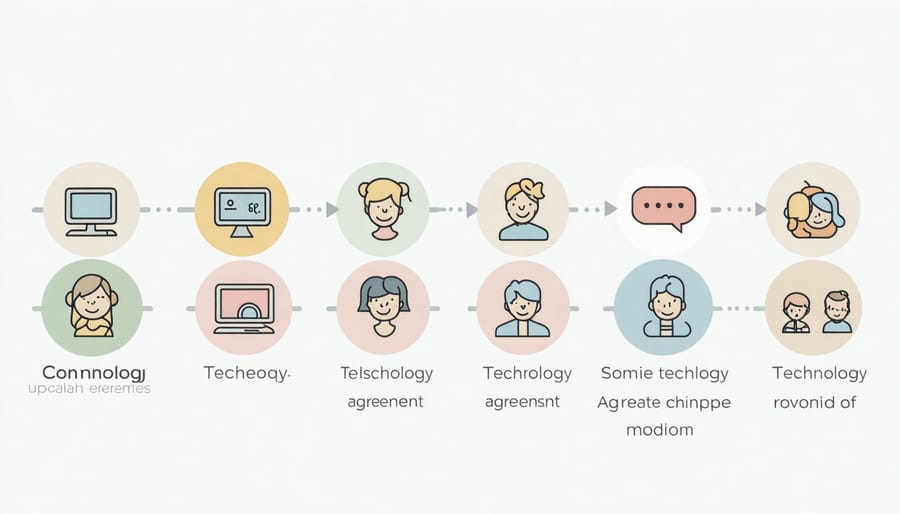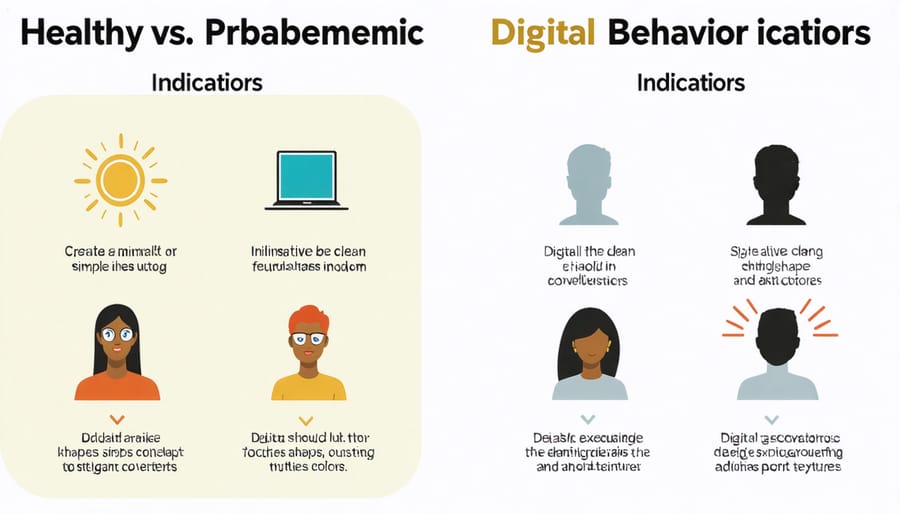In today’s hyperconnected world, managing your child’s digital wellness for kids requires a delicate balance of structure, understanding, and adaptability. Screen time has become an integral part of childhood development, presenting both unprecedented opportunities and unique challenges for modern families.
Research shows that children who develop healthy digital habits early are better equipped to navigate online spaces responsibly, maintain meaningful real-world connections, and harness technology’s educational potential. Yet many parents struggle to establish effective boundaries without creating conflict or resistance.
The key lies not in restricting technology entirely, but in fostering a mindful approach to digital engagement. By understanding the neurological impacts of screen time, recognizing warning signs of excessive use, and implementing age-appropriate guidelines, families can create a sustainable framework for healthy digital behavior.
Whether you’re dealing with a toddler’s first tablet experience or a teenager’s social media presence, the principles of positive digital citizenship remain consistent: balance, boundaries, and open communication. Let’s explore evidence-based strategies that help children thrive in both digital and physical worlds while maintaining their emotional and social well-being.
Understanding Digital Behavior in Children
Age-Appropriate Digital Activities
Children of different ages require distinct digital experiences that align with their developmental stages. For toddlers (ages 2-3), brief, interactive activities like simple educational games or video chats with family members are appropriate, limiting sessions to 15-20 minutes at a time.
Preschoolers (ages 4-5) can benefit from educational apps that teach basic concepts like numbers, letters, and colors. These should be supervised and limited to 30 minutes per session, with an emphasis on interactive learning rather than passive viewing.
Elementary school children (ages 6-11) can handle more complex digital activities, including educational games, basic coding programs, and supervised social interactions. However, daily screen time should be balanced with physical activities and face-to-face social interactions.
Teenagers (ages 12-17) can engage in more sophisticated digital activities, including social media, online research, and creative digital projects. The focus should be on developing responsible habits, critical thinking skills, and digital literacy while maintaining healthy boundaries.
For all age groups, activities should be monitored, include regular breaks, and be part of a balanced lifestyle that includes physical activity, social interaction, and creative play.

Signs of Healthy vs. Problematic Digital Behavior
Recognizing healthy digital behavior can help parents guide their children toward balanced technology use. Healthy signs include maintaining regular sleep patterns, completing homework before screen time, and actively participating in offline activities and social interactions. Children displaying healthy digital habits often show enthusiasm for various activities beyond screens and can easily transition away from devices when needed.
Warning signs of problematic digital behavior may include irritability when device access is limited, declining academic performance, or withdrawal from family activities and face-to-face friendships. Physical symptoms like headaches, eye strain, or disrupted sleep patterns can also indicate excessive screen time.
Dr. Sarah Chen, a child psychologist, notes: “The key difference isn’t necessarily the amount of time spent online, but rather how digital usage impacts daily functioning and emotional well-being.” She encourages parents to observe whether technology enhances or hinders their child’s development and relationships.
A balanced approach might include setting designated screen-free times, maintaining open communication about online activities, and modeling healthy digital habits as parents. Remember that occasional intense interest in digital activities is normal – it’s the overall pattern that matters most.
Creating a Balanced Digital Environment
Setting Realistic Screen Time Limits
Setting realistic recommended screen time limits requires a balanced approach that considers your child’s age, developmental needs, and daily routine. For children under 18 months, screen time should be limited to occasional video chats with family. Between 18-24 months, high-quality educational content can be introduced gradually, always with parent participation.
For preschoolers (ages 2-5), aim for no more than one hour of carefully chosen programming per day. School-age children and teens require more flexible guidelines, focusing on maintaining a healthy balance between screen time and other activities.
Consider creating a family media plan that includes:
– Screen-free zones (like bedrooms and dining areas)
– Screen-free times (during meals, homework, and before bedtime)
– Regular breaks (10 minutes every hour)
– Alternative activities that promote physical movement and face-to-face interaction
Remember that quality matters as much as quantity. Choose educational content, creative apps, and programs that encourage active engagement rather than passive consumption. Be prepared to adjust these limits based on your child’s individual needs and responses.
Lead by example by following similar guidelines yourself. This shows children that screen time management is a family value, not just a rule imposed on them. Stay flexible and open to adjusting limits during special circumstances, like virtual schooling or connecting with distant family members.
Quality vs. Quantity of Digital Activities
When it comes to digital activities, focusing solely on screen time limits might not be the most effective approach. Instead, consider the quality and purpose of your child’s digital engagement. For example, an hour spent creating digital art, coding, or participating in an educational game can be more valuable than two hours of passive scrolling.
Dr. Sarah Chen, a child development specialist, notes: “What matters most is how children interact with technology, not just how long they use it. Active, creative, and social digital activities can support learning and development.”
Consider these questions when evaluating digital activities:
– Is your child learning or creating something?
– Are they connecting meaningfully with others?
– Does the activity support their interests and goals?
– Are they actively engaged rather than passively consuming content?
Help your child make conscious choices about their digital activities. For instance, if they enjoy gaming, encourage them to try games that involve problem-solving or collaboration. If they like social media, guide them toward using it for sharing their creative work or connecting with family.
Remember, balance is key. Even high-quality digital activities should be part of a varied daily routine that includes physical activity, face-to-face interactions, and offline hobbies.
Family Technology Agreements
Creating a family technology agreement is a powerful way to establish clear expectations and healthy digital habits for everyone in the household. Rather than imposing strict rules, involve your children in developing these guidelines to promote buy-in and understanding.
Start by having an open family discussion about both the benefits and challenges of technology use. Ask each family member to share their thoughts on what reasonable limits might look like. Consider addressing key areas like screen-free times (such as during meals or before bedtime), appropriate content guidelines, and privacy rules.
Include positive elements in your agreement, such as earning additional screen time through completing responsibilities or engaging in physical activities. Make sure to outline consequences for breaking the rules, but keep them fair and consistent.
Write down the agreed-upon rules and have everyone sign the document. Display it in a visible place, like on the refrigerator or family bulletin board. Remember that this agreement isn’t set in stone – review and adjust it periodically as your children grow and family needs change.
Lead by example by following the rules yourself, showing your children that digital wellness is important for everyone in the family.

Supporting Positive Digital Habits
Digital Wellness Activities
Establishing healthy digital wellness habits doesn’t have to feel restrictive or punitive. Instead, think of it as creating opportunities for more balanced and mindful technology use. Start by implementing regular “tech breaks” throughout the day – short periods where everyone in the family disconnects from devices to engage in alternative activities.
Create designated device-free zones in your home, such as the dining room or bedrooms, to encourage face-to-face interaction and better sleep habits. Make these spaces inviting by filling them with books, board games, or art supplies. Try the “sunset rule” – turning off screens at least an hour before bedtime to help maintain natural sleep cycles.
Introduce mindful technology practices by teaching children to pause and ask themselves why they’re reaching for their devices. Are they bored? Anxious? Looking for information? This self-awareness helps develop healthier digital habits. Consider using apps that promote mindfulness or track screen time to make children more conscious of their digital consumption.
Make digital breaks fun by planning engaging offline activities. This could include family walks, cooking together, crafting sessions, or indoor obstacle courses. Remember to model these behaviors yourself – children are more likely to embrace digital wellness when they see their caregivers practicing it too.
Celebrate small victories in maintaining digital balance and avoid making technology restrictions feel like punishment. Instead, frame it as making room for other exciting and enriching experiences in life.
Building Digital Resilience
In today’s digital world, building digital resilience is as crucial as teaching children to navigate the physical world safely. Just as we help children develop social skills for face-to-face interactions, we must guide them in managing their online experiences effectively.
Start by having open conversations about digital challenges they might encounter, from cyberbullying to excessive screen time. Encourage them to share their concerns without fear of judgment or punishment. This creates a safe space where they feel comfortable discussing difficult online situations.
Help children establish healthy boundaries by teaching them to:
– Recognize when they need breaks from digital devices
– Trust their instincts about uncomfortable online situations
– Say “no” to inappropriate content or interactions
– Seek help when they encounter challenges
Practice scenario-based learning with your children. Ask them how they would handle specific situations, like receiving unkind messages or feeling pressured to share personal information. Guide them toward positive solutions while allowing them to develop their problem-solving skills.
Remember that resilience grows through experience. Allow children to face and overcome minor digital challenges under your guidance. This builds confidence and helps them develop the skills they’ll need to handle more complex situations independently as they grow older.
Model healthy digital habits yourself. Children learn best when they see adults setting good examples of balanced technology use and positive online interactions.
When to Seek Professional Help

Warning Signs
Recognizing signs of problematic device use early can help parents and caregivers address digital behavior concerns before they become serious issues. Watch for changes in your child’s sleep patterns, particularly difficulty falling asleep or reluctance to put devices away at bedtime. Notice if your child becomes irritable or anxious when separated from their devices, or if they consistently choose screen time over previously enjoyed activities like sports or face-to-face social interactions.
Physical symptoms can also indicate excessive device use, including headaches, eye strain, poor posture, or complaints of neck pain. Pay attention if your child’s grades begin to slip or if they’re having trouble completing homework due to digital distractions. Another red flag is when children become secretive about their online activities or react defensively when asked about their screen time.
Social withdrawal from family activities or in-person friendships, combined with an increasing preference for online interactions, may suggest unhealthy digital habits. Additionally, watch for signs of emotional dependence on social media validation or gaming achievements, such as mood swings related to online feedback or gaming outcomes.
Remember that these warning signs don’t necessarily indicate a serious problem, but they do warrant open, supportive conversations about establishing healthier digital habits.
Available Support Resources
If you’re concerned about your child’s digital behavior, numerous support resources are available to help. Professional counselors and child psychologists specializing in digital wellness can provide personalized guidance and strategies. Many schools now offer digital literacy programs and counseling services focused on healthy technology use.
Organizations like Common Sense Media provide free resources, including expert advice, family guides, and educational materials. The American Academy of Pediatrics offers guidelines and tools for families navigating digital challenges, including their Family Media Use Plan tool.
Local community centers and libraries often host workshops and support groups where parents can share experiences and learn from others facing similar challenges. Many healthcare providers now include digital behavior screening in routine check-ups and can refer you to appropriate specialists if needed.
For immediate support, several helplines specialize in digital wellness and online safety. The National Parent Helpline (1-855-427-2736) offers emotional support and resources to parents struggling with any parenting challenges, including digital behavior concerns.
Remember, seeking help early can prevent minor concerns from developing into more serious issues. Your child’s pediatrician can be an excellent first point of contact, as they can assess the situation and recommend appropriate resources or specialists based on your family’s specific needs.
As we navigate the increasingly digital world, managing healthy digital behavior has become an essential life skill for both children and adults. Throughout this discussion, we’ve explored the various aspects of digital behavior and its impact on our daily lives, relationships, and well-being.
Remember that creating healthy digital habits isn’t about completely restricting technology use – it’s about finding the right balance. By setting clear boundaries, modeling positive behavior, and maintaining open communication with our children, we can help them develop a healthy relationship with digital devices.
The key takeaways from our discussion include the importance of establishing consistent screen time limits, creating device-free zones and times, and encouraging alternative activities that promote physical and social development. We’ve also learned that digital behavior management should be approached with flexibility and understanding, as each child’s needs and circumstances are unique.
Moving forward, consider implementing the strategies we’ve discussed gradually, celebrating small successes along the way. Stay involved in your child’s digital life while respecting their growing independence, and remember that it’s okay to adjust your approach as needed.
By fostering positive digital habits early on, we’re not just managing today’s challenges – we’re preparing our children for a future where digital literacy and healthy online behavior are crucial life skills. Let’s commit to being positive digital role models and supporting our children in developing responsible digital citizenship.



